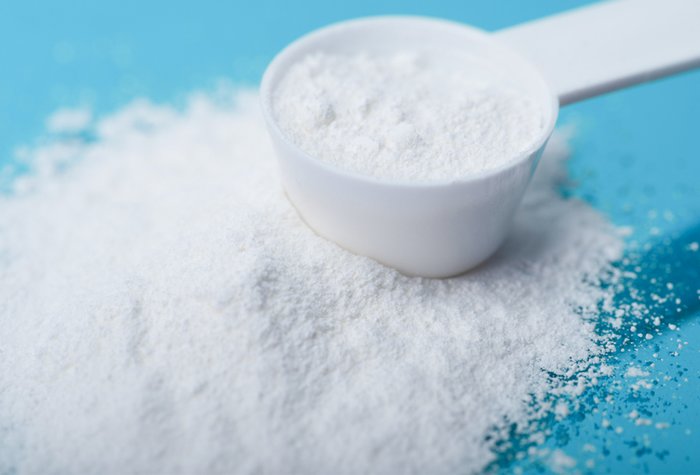What is Creatine? What does it do to your body? Is it essential?
This post answers all your basic queries about the uses and benefits of Creatine.

Chances are that you might be familiar with the word “Creatine”. You probably would have heard of it from a fitness enthusiast, read about it in a magazine or blog, or simply have seen those giant boxes in various sports supplement stores, promising “enhanced muscles”. Just what exactly is it? It is an organic component which is naturally produced by all vertebrates. Three Amino acids – Arginine, Glycine and Methionine – are involved in the production of this non-protein compound. Creatine is majorly produced in the liver of vertebrates; because of this, it is considered a nonessential component.
For the normal individual, consuming a healthy balanced diet containing the recommended levels of Arginine, Glycine and Methionine, among other essential amino acids (the building blocks of proteins) is more than enough to meet the required needs of this molecule. However, those expending a lot of energy, like athletes, sportsmen and weightlifters, require a lot of creatine. This could only be satisfied by consuming supplements.
The Science behind Creatine
As mentioned earlier, this is a naturally occurring non-protein, non-steroidal component. This molecule plays a major role in the consumption of energy molecules, which is also known as Adenosine Tri-Phosphate (ATP). The mitochondria, an organelle present in every cell of the human body, synthesise Adenosine Tri-Phosphate. To release energy, this molecule is transformed into Adenosine Di-Phosphate (ADP). Our body uses these molecules to synthesize energy. However, the mitochondrial barrier does not facilitate ATP molecules to move out of it. It does facilitate the movement of ADP molecules through the barrier.
Enter Creatine. This molecule is converted into Phosphocreatine, with the help of the enzyme Creatine Kinase. Phosphocreatine then reacts with Adenosine Di-Phosphate, again in the presence of Creatine Kinase, to form Creatine and Adenosine Tri-Phosphate. Simply put, this molecule helps in increasing the net energy available for the muscle cells to work without getting tired.
Our muscles have the capacity to store a significant amount of this component. Adding extra creatine to the reservoir makes it possible for our boy to resynthesize ATP molecules from ADP molecules at a much higher rate.
Benefits of Creatine
The primary role of creatine in our body is to enhance the athletic performance of an individual. As discussed earlier, the phosphocreatine stored in our muscle cells is responsible for recycling Adenosine Di-Phosphate (ADP) into Adenosine Tri-Phosphate (ATP). Naturally, when the levels of ATP increase, one has more energy, which can be expended in performing high-intensity exercises and other athletic activities. Research has also found that increased levels of this molecule in the body play an important role in improving the cognitive ability of the person.
Creatine helps in boosting the workload of the individual, by allowing the individual to work for a longer period of time without experiencing fatigue. It also helps in raising the levels of certain anabolic hormones. Anabolic hormones are those that are involved in the process of anabolism (building up of essential organic components and cells). They play a role in the growing, healing and repairing processes of the muscle cells.
Another way in which Creatine helps with the growth of muscles is its effect on the levels of Myostatin. Myostatin is a protein which plays an important role in inhibiting the excess growth of new muscles. When these supplements are taken, it reduces the levels of Myostatin in the body. Thus, it further encourages the growth of muscles.
What happens if my levels of creatine are low?
Our body needs creatine to help compensate for the loss of ATP molecules, and also give an instant and prolonged boost to the body during an intense workout session. Hence, maintaining at the very least the recommended levels of creatine in our body is essential. The deficiency of this molecule is linked to lowered cognitive functions, as the body is not able to produce enough Adenosine Tri-Phosphate molecules needed for effective brain functioning. Creatine deficiency is found to be linked with Parkinson’s disease (a nervous system disorder that affects the movement of the skeletal muscles), though more research is needed in this field.
The lack of creatine is also linked with muscle atrophy. This is again due to the reduced turnover rate of ADP into ATP. Because the levels of ATP are lower than normal, the individual gets tired very soon, even for low intensity activity. Because of this, the person becomes lethargic (lacking the energy to do a job) and tends to work less. This leads to their muscles not being used for a long period of time, eventually leading to muscle atrophy.
Shop for Creatine here at Fodvez.

